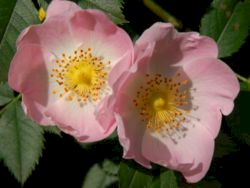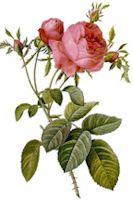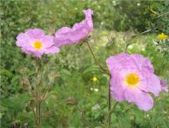|

Dog Rose |
Certain curative properties are possessed both by the Briar, or wild Dog Rose of our country hedges, and by the cultivated varieties of this queen of flowers in our Roseries. The word Rose means red, from the Greek rodon, connected also with rota, a wheel, which resembles the outline of a Rose. The name Briar is from the Latin bruarium, the waste land on which it grows. The first Rose of a dark red color, is held to have sprung from the blood of
Adonis. The fruit of the wild Rose, which is so familiar to every admirer of our hedgerows in the summer, and which is the common progenitor of all Roses, is named Hips. "Heps maketh," says Gerard, "most pleasant meats or banquetting dishes, as tarts and such like, the |
concoction whereof I commit to the cunning cook, and teeth to eat them in the rich man's mouth."
|

Rose Hips |
Hips, derived from the old Saxon, hiupa, jupe, signifies the Briar rather than its fruit. They are called in some parts, "choops," or "hoops." The woolly down which surrounds the seeds within the Hips serves admirably for dispelling round worms, on which it acts mechanically without irritating the mucous membrane which lines the bowels.
When fully ripe and softened by frost, the Hips, after removal of their hard seeds, and when plenty of sugar is added, make a very nice confection, which the Swiss and Germans eat at dessert, and which forms an agreeable substitute for tomato sauce. Apothecaries employ this conserve in the preparing of electuaries, and as a basis for pills. They also officially use the petals of the Cabbage Rose (Centifolia) for making Rose
water, and the petals of the Red |
Rose (Gallica) for a cooling infusion, the brilliant colour of which is much improved by adding some diluted sulphuric acid; and of these petals they further direct a syrup to be concocted.
Next in development to the Dog Rose, or Hound's Rose, comes the Sweetbriar (Eglantine), with a delicate perfume contained under its glandular leaves. "Fragrantia ejus olei omnia alia odoramenta superest." This (Rosa rubiginosa) grows chiefly on chalk as a bushy shrub. Its poetic title, Eglantine, is a corruption of the Latin aculeius, prickly. A legend tells that Christ's crown of thorns was made from the Rose-briar, about which it has been beautifully said:
"Men sow the thorns on Jesus' brow,
But Angels saw the Roses."
Pliny tells a remarkable story of a soldier of the Praetorian guard, who was cured of hydrophobia, against all hope, by taking an extract of the root of the "Kunoroddon", Dog Rose, in obedience to the prayer of his mother, to whom the remedy was revealed in a dream; and he says further, that it likewise restored whoever tried it afterwards. Hence came the title "Canina". "Parceque elle a longtemps ? en vogue pour guerir de la rage."
But the term, Dog Rose, is generally thought to merely signify a flower of lower quality than the nobler Roses of garden culture.
The five graceful fringed leaflets which form the special beauty of the Eglantine flower and bud, have given rise to the following Latin enigma (translated):
"Of us five brothers at the same time born,
Two from our birthday always beards have worn:
On other two none ever have appeared,
While our fifth brother wears but half a beard."
From Roses the Romans prepared wine and confections, also subtle scents, sweet-smelling oil, and medicines. The petals of the crimson French Rose, which is grown freely in our gardens, have been esteemed of signal efficacy in consumption of the lungs since the time of Avicenna, A.D. 1020, who states that he cured many patients by prescribing as much of the conserve as they could manage to swallow daily. It was combined with milk, or with some other light nutriment; and
generally from thirty to forty pounds of this medicine had to be consumed before the cure was complete. Julius Caesar hid his baldness at the age of thirty with Roman Roses.
"Take," says an old MS. recipe of Lady Somerset's, "Red Rose buds, and clyp of the tops, and put them in a mortar with ye waight of double refined sugar; beat them very small together, then put it up; must rest three full months, stirring onces a day. This is good against the falling sickness."
It is remarkable that while the blossoms of the Rose Order present various shades of yellow, white, and red, blue is altogether foreign to them, and unknown among them.
As the Thistle is symbolical of Scotland, the Leek of Wales, and the Shamrock of Ireland: so the sweet, pure, simple, honest Rose of our woods is the apt-chosen emblem of Saint George, and the frank, bonny, blushing badge of Merrie England.
|

Cabbage Rose |
The petals of the Cabbage Rose (Centifolia), which are closely folded over each other like the leaves of a cabbage, have a slight laxative action, and are used for making Rose-water by distillation, whether when fresh, or after being preserved by admixture with common salt. This perfumed water has long enjoyed a reputation for the cure of inflamed eyes, more commonly when combined with zinc, or with
sugar of lead. Hahnemann quotes the same established practice as a tacit avowal that there exists in the leaves of the Rose some healing power for certain diseased conditions of the eyes, which virtue is really founded on the homoeopathic property possessed by the Rose, of exciting a species of ophthalmia in healthy persons; as was observed by Echtius, Ledelius, and Rau.
|
It is recorded also in his "Organon of Medicine", that persons are sometimes found to faint at the smell of Roses (or, as Pope puts it, to "die of a rose in aromatic pain"); whereas the Princess Maria, cured her brother, the Emperor Alexius, who suffered from faintings, by sprinkling him with Rose-water, in the presence of his aunt Eudoxia.
The wealthy Greeks and Romans strewed Roses on the tombs of departed friends, whilst poorer persona could only afford a tablet at the grave bearing the prayer:
"Sparge, precor, rosas super mea busta, viator."
"Scatter Roses, I beseech you, over my ashes, O pitiful passer-by."
But nowadays many persons have an aversion to throwing a Rose into a grave, or even letting one fall in.
Roses and reticence of speech have been linked together since the time of Harpocrates, whom Cupid bribed to silence by the gift of a golden Rose-bud; and therefore it became customary at Roman feasts to suspend over the table a flower of this kind as a hint that the convivial sayings which were then interchanged wore not to be talked of outside. What was spoken "sub vino" was not to be published "sub divo":
"Est rosa flos veneris, cujus quo facta laterent Harpocrati, matris dona, dicavit amor: Inde rosam mensis hospes suspendid amicis, Conviva ut sub e?icta tacenda sciat."
For the same reason the Rose is found sculptured on the ceilings of banqueting rooms; and in 1526 it began to be placed over Confessionals. Thus it has come about that the Rose is held to be the symbol of secrecy, as well as the flower of love, and the emblem of beauty: so that the significant phrase "sub rosa,"--under the Rose,--conveys a recognized meaning, understood, and respected by everyone. The bed of Roses is not altogether a poetic fiction. In old days the Sybarites
slept upon mattresses which were stuffed with Rose petals: and the like are now made for persons of rank on the Nile.
A memorial brass over the tomb of Abbot Kirton, in Westminster Abbey, bears testimony to the high value he attached during life to Roses curatively:
"Sis, Rosa, flos florum, morbis medicina meoium."
Many country persons believe, that if Roses and Violets are plentiful in the autumn, some epidemic may be expected presently. But this conclusion must be founded like that which says, "a green winter makes a fat churchyard," on the fact that humid warmth continued on late in the year tends to engender putrid ferments, and to weaken the bodily vigor.
Attar of Roses is a costly product, because consisting of the comparatively few oil globules found floating on the surface of a considerable volume of Rose water thrice distilled. It takes five hundredweight of Rose petals to produce one drachm by weight of the finest Attar, which is preserved in small bottles made of rock crystal. The scent of the minutest particle of the genuine essence is very powerful and enduring:--
"You may break, you may ruin, the vase if you will, But the scent of the Roses will hang round it still."
The inscription, Rosamundi, non Rosa munda, was graven on the tomb of fair Rosamund, the inamorata of Henry the Seventh:
"Hic jacet in tomb?osa Mundi, non Rosa munda;
Non redolet, sed olet quae redolere solet."
"Here Rose the graced, not Rose the chaste, reposes; The smell that rises is no smell of Roses."
In Sussex, the peculiar excrescence which is often found on the Briar, as caused by the puncture of an insect, and which is known as the canker, or "robin redbreast's cushion," is frequently worn round the neck as a protective amulet against whooping cough. This was called in the old Pharmacopeias "Bedeguar," and was famous for its astringent properties. Hans Andersen names it the "Rose King's beard."
The Rosary was introduced by St. Dominick to commemorate his having been shown a chaplet of Roses by the Blessed Virgin. It consisted formerly of a string of beads made of Rose leaves tightly pressed into round moulds and strung together, when real Roses could not be had. The use of a chaplet of beads for recording the number of prayers recited is of Eastern origin from the time of the Egyptian Anchorites.
|

Rock Rose |
The Rock Rose (a Cistus), grows commonly in our hilly pastures on a soil of chalk, or gravel, bearing clusters of large, bright, yellow flowers, from a small branching shrub. These flowers expand only in the sunshine, and have stamens which, if lightly touched, spread out, and lie down on the petals. The plant proves medicinally useful, particularly if grown in a soil containing magnesia. A tincture is
prepared (H.) from the whole plant, English or Canadian, which is useful for curing shingles, on the principle of its producing, when taken by healthy provers in doses of various potencies, a cutaneous outbreak on the |
trunk of the body closely resembling the characteristic symptoms of shingles, whilst attended with nervous distress, and with much burning of the affected skin. The plant has likewise a popular reputation for healing scrofula, and its tincture is beneficial for reducing enlarged glands, as of the neck and throat; also for strumous swelling of the knee joint, as well as of other joints. It is a "helianthemum" of the Sunflower tribe.
The Canadian Rock Rose is called Frostwort and Frostweed, because crystals of ice shoot from the cracked bark below the stem during freezing weather in the autumn.
A decoction of our plant has proved useful in prurigo (itching), and as a gargle for the sore throat of scarlet fever. For shingles, from five to ten drops of the tincture, third decimal strength, should be given with a spoonful of water three times a day.
Herb Simples
The Primitive Simplers presented here show the way of life in other generations, it is not suggested or recommended trying them yourself. |
|
Garden
Herbs
Home
History of Herbs
Herb Gardening
Herbs for Beginners
Drying & Preserving Herbs
Indoor Herb Gardening
Herb Garden
Hints & Tips
Herbal
Cooking
Herb Chart
Using Herbs
Culinary Herbs
Herb
Oil and Vinegar
Herb Teas
Herb Candy
Herb Jelly
Herb Simples
Preface
Introduction
Alphabetical Listing

Trade
Recipes Online
Share your Recipes with others!!
|





